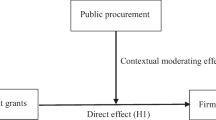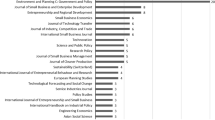Abstract
The paper examines the proposition from the law of 1 over n (Weingast et al. 1981) that project size tends to increase with common pool size. Comparable studies have tended, firstly, to focus on assets and debt rather than on expenditures and, secondly, on district population rather than on the number of districts as in the original formulation of the law. Both issues are sought to be remedied in this paper. The proposition is examined on Danish municipal expenditures from 1996 to 2006, using municipal mergers towards the end of this period as a quasi-experiment. A difference-in-difference identification strategy and a subsample strategy are used to identify the effect of the availability and size of a common pool on municipal expenditures. The paper finds positive, statistically and economically significant effects of the availability and size of a common pool in the final year of the treatment period. The importance of the number of districts over district population suggests a reappraisal of the law of 1 over n as originally formulated.


Similar content being viewed by others
Notes
The Danish municipal mergers deviate from the model by Weingast et al. (1981) in two respects: Firstly, the decision-making process did not follow a norm of universalism, but the collective decision materializes as the product of the merging municipalities’ decisions. Secondly, the model assumes that only a single political representative is elected from each district while multimember districts are used in Danish local government. However, this is arguably less important as it is already assumed that politicians care exclusively for their local electorate’s interests.
One might argue that the latter will act as a proxy for the former. However, a merging municipality’s population can account for a small or a large share of the newly merged municipality’s population without the number of municipalities in the merger being correspondingly lower or higher. Such deviations occur frequently in the case examined in this paper (r=0.50; n=217).
The number of municipalities varied between 270 and 275 from 2003 to 2006. Of these, 21 to 26 were excluded based on three criteria: if a municipality has had both municipal and county tasks, has been part of a merger not directly associated with the 2007 merger reform, or has been put under administration in the time period or a number of years before.
The assumption of a common trend in the DD design makes it well suited for analyses of subnational governments such as the Danish municipalities, which are all subject to the same overall legal and political framework.
The specifications of Eqs. (1) and (2) can be extended to account for persistence over time. Firstly, the period-specific specification in Eq. (1) is less sensitive to persistence over time as collapsing the data into a pre- and post-treatment period produces consistent standard errors when serial correlation is present (Bertrand et al. 2004). Secondly, all models are estimated with standard errors clustered at the municipal level. Finally, fixed effects specifications of all models, estimated using deviations from means, are also considered.
The explanatory power of the models with controls for changes in final accounts is a respectable 14–19 %. For budget overruns, however, the explanatory power is lower at 4–6 %. The explanatory power of the subsample design (examined in the next section) is similar at 11–15 % and 3–7 %.
For both outcome measures, excluding cases of doubt leads to marginal increases in the treatment effects. Furthermore, models (1)–(16) were reestimated using robust regression to investigate the influence of outliers. The treatment effects retain their significance except for model (2), and the estimates tend to be reduced, but decrease by no more than about a third. All models were also re-estimated with White heteroscedasticity-consistent standard errors, which make the treatment effect in models (2) and (6) turn insignificant. This does not lead to a different conclusion for the availability or size of the common pool. In addition, fixed effects specifications of all models were also estimated, which likewise produces very similar results. Models (2), (4), (10), and (12) were also reestimated with a binary indicator of population size (below, equal to or above 20,000 inhabitants, cf. the agreement on the reform) instead of logged population size. However, this yields only small changes in the treatment effects. As a final note, the identification strategy calls for the use of interactions which can create problems with multicollinearity. This can result in too large standard errors that increase the chance of Type II error, and hence, overly conservative test statistics (Gujarati 2003: Chap. 10). Multicollinearity is therefore more problematic in cases with nonfindings. The largest variance inflation factors are around ten in the models estimated on the full sample, and at the most six in the models for subsample #2. The highest values are found primarily for the interactions.
References
Baldersheim, H. & Rose, L. E. (Eds.), (2010). Territorial choice: the politics of boundaries and borders. Hampshire: MacMillan.
Bertrand, M., Duflo, E., & Mullainathan, S. (2004). How much should we trust differences-in-differences estimates? Quarterly Journal of Economics, 119, 249–275.
Bhatti, Y., & Hansen, K. M. (2011). Who ‘marries’ whom? The influence of societal connectedness, economic and political homogeneity, and population size on jurisdictional consolidations. European Journal of Political Research, 50, 212–238.
Blom-Hansen, J. (2002). Budget procedures and the size of the budget: evidence from danish local government. Scandinavian Political Studies, 25, 85–106.
Blom-Hansen, J. (2007). Pengeafbrænding før lukketid? Om kommunernes økonomiske dispositioner op mod kommunesammenlægningerne i 2007. In V. L. Nielsen & N. Ploug (Eds.), Når politik bliver til virkelighed. Festskrift til professor søren winter, Copenhagen: The Danish National Centre for Social Research.
Blom-Hansen, J. (2010). Municipal amalgamations and common pool problems: the Danish local government reform in 2007. Scandinavian Political Studies, 33, 51–73.
Citrin, J. (1979). Do people want something for nothing: public opinion on taxes and government spending. National Tax Journal, 32, 113–129.
Cook, T. D., & Campbell, D. T. (1979). Quasi-experimentation. Design & analysis issues for field settings. Boston: Houghton Mifflin.
Executive order No. 656 of 06/29/2005. Bekendtgørelse om revision af den kommunale og regionale inddeling og om forpligtende kommunale samarbejder.
Gujarati, D. N. (2003). Basic econometrics (4th ed.). New York: McGraw Hill/Irwin.
Hansen, S. W. (2011). Towards genesis or the grave. Financial effects of local government mergers. Odense: University of Southern Denmark Press.
Hinnerich, B. T. (2009). Do merging local governments free ride on their counterparts when facing boundary reform? Journal of Public Economics, 93, 721–728.
Houlberg, K. (1999). Budgetoverskridelsernes anatomi. Nordisk Administrativt Tidsskrift, 80, 200–232.
Imbens, G. W., & Wooldridge, J. M. (2008). Recent developments in the econometrics of program evaluation. Discussion Paper No. 3640. IZA DP No. 3640. Bonn: Institute for the Study of Labor.
Jordahl, H., & Liang, C.-Y. (2010). Merged municipalities, higher debt: on free-riding and the common pool problem in politics. Public Choice, 143, 157–172.
Kristensen, O. P. (1980). The logic of political bureaucratic decision-making as a cause of governmental growth: or why expansion of public programs is a “private good” and their restriction is a “public good”. European Journal of Political Research, 8, 249–264.
Kristensen, O. P. (1987). Væksten i den offentlige sektor. Institutioner og politik. Copenhagen: Juristog Økonomforbundets Forlag.
Ministry of the Interior and Health (2004). Agreement on a structural reform. Copenhagen: Ministry of the Interior and Health.
Mouritzen, P. E. (1989). The local political business cycle. Scandinavian Political Studies, 12, 37–55.
Mouritzen, P. E. (1991). Den politiske cyklus. En undersøgelse af vælgere, politikere og bureaukrater i kommunalpolitik under stigende ressourceknaphed. Aarhus: Politica.
Mouritzen, P. E. (2010). The Danish revolution in local government. How and why? In H. Baldersheim & L. E. Rose (Eds.), Territorial choice: the politics of boundaries and borders. Hampshire: MacMillan.
Olson, M. (1965). The logic of collective action. Public goods and the theory of groups. Cambridge: Harvard University Press.
Ostrom, E. (1990). Governing the commons. The evolution of institutions for collective action. Cambridge: Cambridge University Press.
Primo, D. M., & Snyder Jr., J. M. (2008). Distributive politics and the law of 1/n. The Journal of Politics, 70, 477–486.
Serritzlew, S. (2005). Breaking budgets: an empirical examination of Danish municipalities. Financial Accountability & Management, 21, 413–435.
Thießen, U. (2003). Fiscal decentralisation and economic growth in high-income OECD countries. Fiscal Studies, 24, 237–274.
Weingast, B. R., Shepsle, K. A., & Johnsen, C. (1981). The political economy of benefits and costs: a neoclassical approach to distributive politics. The Journal of Political Economy, 89, 642–664.
Winter, S., & Mouritzen, P. E. (2001). Why people want something for nothing: the role of asymmetrical illusions. European Journal of Political Research, 39, 109–143.
Acknowledgements
The study is based on the author’s dissertation initiated in 2006 and concluded in 2009 (Hansen 2011). The author thanks the Research Programme on the Structural Reform, the Local Government Foundation for Education and Research, the Ministry of Social Welfare, and the Department of Political Science and Public Management at the University of Southern Denmark, for funding my Ph.D. project as well as Professors Poul Erik Mouritzen and Asbjørn Sonne Nørgaard, Associate Professor Robert Klemmensen, and numerous other people, who shall remain unnamed for the sake of brevity, for constructive thoughts and comments.
Author information
Authors and Affiliations
Corresponding author
Appendix: variable definitions
Appendix: variable definitions
All economic variables are deflated using prices and wages for the municipal sector with base year in 2000.
Budget overruns Appropriations subtracted from final accounts on tax-financed current expenditures in a given year. Sources for final accounts and Statistics Denmark’s StatBank, tables BUD1, BUD32X, and BUD32.
Election year Coded one in election years and zero in nonelection years.
Expenditure needs Calculated by the Ministry of the Interior and Health (source is http://www.noegletal.dk). Change from preceding year is expressed as actual change, not in percent.
Merged Coded one for merged and zero for not merged municipalities (source is Executive order 656/2005).
Number of municipalities in merger Coded as number of municipalities in each group of merging municipalities (ibid.).
One-year change in final accounts Change in tax-financed current expenditures from preceding year (source is Statistics Denmark’s StatBank, tables REG11 and REG31).
Population Municipal population in 1000 s as of 1 January (source is Statistics Denmark’s StatBank, table BEF1A). Change from preceding year is expressed in percent.
Share of young and elderly Share of inhabitants aged 0–17 or 65+ in percent of municipal population, both as of 1 January (source is Statistics Denmark’s StatBank, table BEF1A). Change is expressed as changes in percentage.
Tax base Budgeted total tax base (source is Ministry of the Interior and Health, http://www.noegletal.dk). Change from preceding year is expressed as actual change, not in percent.
Rights and permissions
About this article
Cite this article
Welling Hansen, S. Common pool size and project size: an empirical test on expenditures using Danish municipal mergers. Public Choice 159, 3–21 (2014). https://doi.org/10.1007/s11127-012-0009-y
Received:
Accepted:
Published:
Issue Date:
DOI: https://doi.org/10.1007/s11127-012-0009-y




